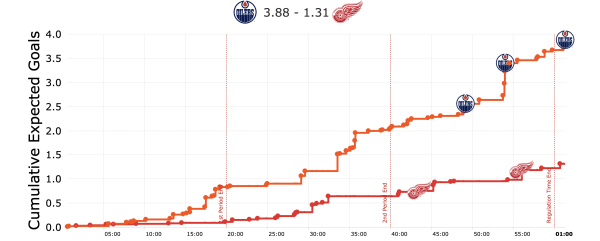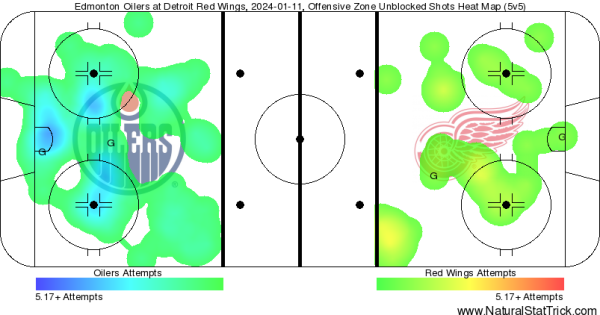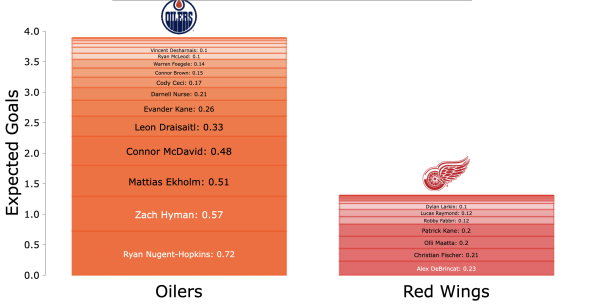
A dive into the underlying numbers from the Oilers 3-2 overtime win in Detroit Thursday
A dive into the underlying numbers from the Oilers 3-2 overtime win in Detroit Thursday
On Thursday night in Detroit, the Red Wings did their best to corral the globe's best hockey player, and they very nearly managed to slip past Connor McDavid and the scoring hot Edmonton Oilers, but in the end, McDavid proved inevitable. The Oilers collected a come-from-behind overtime victory.
On some level, it feels a frivolous game to assess statistically.
The stats are profoundly unflattering to a Red Wing team that actually did a decent job of keeping McDavid and company under control. Meanwhile, McDavid's brilliant third period goal offers a far clearer portrait of his performance than any statistic—advanced or otherwise—possibly could. Still, let's take a look at the underlying numbers for a different perspective on how this game unfolded.

The Big Picture
-By all situations expected goals, the Oilers dominated to the tune of a 3.88-1.31 advantage. The Red Wings were never able to sustain any meaningful offense to speak of, and Edmonton steadily built a commanding advantage. After one period, they led 0.829-0.107 by xG; after two, 2.028-0.646; after three, 3.666-1.225; after overtime, 3.88-1.311. Per MoneyPuck's Deserve To Win O'Meter, the Oilers earned an 85.3% chance of victory.

-Natural Stat Trick's five-on-five numbers also show the Oilers' dominance. Detroit managed just a 40.18% share of shots, a 39.62% share of scoring chances, a 21.43% share of high-danger chances, and a measly 20.94% share of expected goals. The below five-on-five unblocked shots heat map shows the way Edmonton created a surplus of offense from all over the attacking zone, while the Red Wings struggled to generate a high rate of chances anywhere.

-After the game, Andrew Copp offered a detailed perspective on just how taking on McDavid lead to a game in which "a lot of your focus can end up on defending." Because of the Oilers' aptitude for sustaining possession in the offensive zone, Detroit often ended up able to do nothing on its shifts but get the puck out of the zone and change, with even that proving a considerable challenge. That dynamic inevitably looks ugly in the underlying numbers, but it is also the reality of how the Red Wings had to play in a game like this, and, thanks to Copp's third-period goal, Detroit nearly pulled it off that put the Red Wings ahead 1-0.
Individual Impacts
-This section has to begin with McDavid. One goal and no assists feels like a meager night for a player who put up 64 goals and 153 points a year ago, but McDavid was nothing short of phenomenal on Thursday.
His line with Zach Hyman and Ryan Nugent-Hopkins played 15:50 (roughly six-and-a-half minutes more than the next closest Edmonton line) and proved an unstoppable force. They led 1.716-0.158 by xG in those minutes (a 91.6% share) and outscored the Red Wings 2-0.
Perhaps the silliest part of it all is that, despite those overwhelming underlying numbers and on-ice results, it still felt as though Detroit did about as well as it could in those minutes.
As Derek Lalonde put it after Friday's practice, "Grade A chances, [McDavid] was involved in almost 13. We go through games with only giving up 12 or 13...It was unbelievable watching it back, but again, I thought we did a pretty good job of limiting it, not giving them second chances, bending and not breaking...I haven't seen a player take over a game like that in a long time."

-The Jake Walman-Moritz Seider pairing had to bear the brunt of the McDavid match-up. Seider was on the ice for 13:43 against McDavid at five-on-five. As a pair, Walman-Seider suffered in terms of the shot data, taking an 0.091-0.713 disadvantage in on-ice xG, but interestingly, they weren't on the ice together for either goal. The first Oilers goal came with Walman beside Jeff Petry (and Detroit in the midst of a rather frantic change); the second came with Seider beside Ben Chiarot.
-Zero Red Wings finished the night at a greater than 50% share of on-ice xG, with Olli Maatta coming the closest at 49.54%.
-No Detroit line managed to create so much as 0.3 xG. The top line of Dylan Larkin, Lucas Raymond, and David Perron came the closest at 0.283, but they managed just a 28.3% on-ice xG share in their 12:33 together at five-on-five. They did, however, finish the game even on the scoreboard with a goal for and a goal against.
The third line of Michael Rasmussen, Andrew Copp, and Christian Fischer was probably Detroit's best. They played 9:55 together at five-on-five and while they posted only a 38.15% share of on-ice xG, they scored once without giving up a goal.
Meanwhile, this was a step backwards for the second line of Alex DeBrincat, J.T. Compher, and Patrick Kane. That trio—which had enjoyed one of its best performances as a unit against Anaheim Sunday—suffered in its match-up with Leon Draisaitl's line. In 12:52 at five-on-five, they put up just a 21.9% share of on-ice xG, seeming to have tremendous difficulty with Draisaitl and company's ability to sustain possession low in the offensive zone.
-Finally, this was another excellent night for Alex Lyon—the number one reason Detroit got to overtime on a night in which ti was so thoroughly outshot. Lyon stopped 44 of the 47 shots he faced. The three goals he allowed came on 3.88 xG, earning him 0.88 Goals Saved Above Expected. With each passing game, Lyon further solidifies his claim to being the Red Wings' long-term starter.
Also from THN Detroit
Breaking: Red Wings '23 First Rounder Danielson Traded to WHL's Portland Winterhawks
Red Wings 3, Ducks 2: Detroit Grabs Late Win to Complete Perfect California Trip
Film Study: Kane, Raymond Prove the Value of Shootout Width in Red Wings' Win Over LA

